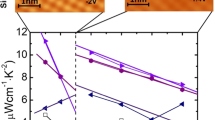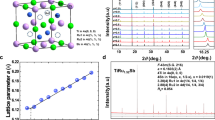Abstract
Filled skutterudites RxCo4Sb12 are excellent n-type thermoelectric materials owing to their high electronic mobility and high effective mass, combined with low thermal conductivity associated with the addition of filler atoms into the void site. The favourable electronic band structure in n-type CoSb3 is typically attributed to threefold degeneracy at the conduction band minimum accompanied by linear band behaviour at higher carrier concentrations, which is thought to be related to the increase in effective mass as the doping level increases. Using combined experimental and computational studies, we show instead that a secondary conduction band with 12 conducting carrier pockets (which converges with the primary band at high temperatures) is responsible for the extraordinary thermoelectric performance of n-type CoSb3 skutterudites. A theoretical explanation is also provided as to why the linear (or Kane-type) band feature is not beneficial for thermoelectrics.
This is a preview of subscription content, access via your institution
Access options
Subscribe to this journal
Receive 12 print issues and online access
$259.00 per year
only $21.58 per issue
Buy this article
- Purchase on Springer Link
- Instant access to full article PDF
Prices may be subject to local taxes which are calculated during checkout



Similar content being viewed by others
References
Caillat, T., Borshchevsky, A. & Fleurial, J. P. Properties of single crystalline semiconducting CoSb3 . J. Appl. Phys. 80, 4442–4449 (1996).
Tang, Y., Chen, S. W. & Snyder, G. J. Temperature dependent solubility of Yb in Yb–CoSb3 skutterudite and its effect on preparation, optimization and lifetime of thermoelectrics. J. Materiom. 1, 75–84 (2015).
Pei, Y. Z. et al. Improving thermoelectric performance of caged compounds through light-element filling. Appl. Phys. Lett. 95, 042101 (2009).
Chen, L. D. et al. Anomalous barium filling fraction and n-type thermoelectric performance of BayCo4Sb12 . J. Appl. Phys. 90, 1864–1868 (2001).
Tang, Y. et al. Phase diagram of In–Co–Sb system and thermoelectric properties of In-containing skutterudites. Energy Environ. Sci. 7, 812–819 (2014).
Tang, Y., Hanus, R., Chen, S. W. & Snyder, G. J. Solubility design leading to high figure of merit in low-cost Ce–CoSb3 skutterudites. Nature Commun. 6, 7584 (2015).
Li, H., Tang, X., Zhang, Q. & Uher, C. High performance InxCeyCo4Sb12 thermoelectric materials with in situ forming nanostructured InSb phase. Appl. Phys. Lett. 94, 102114 (2009).
Rogl, G. et al. n-type skutterudites (R, Ba, Yb)yCo4Sb12 (R = Sr, La, Mm, DD, SrMm, SrDD) approaching ZT ≍ 2.0. Acta Mater. 63, 30–43 (2014).
Shi, X. et al. Multiple-filled skutterudites: High thermoelectric figure of merit through separately optimizing electrical and thermal transports. J. Am. Chem. Soc. 133, 7837–7846 (2011).
Meisner, G., Morelli, D., Hu, S., Yang, J. & Uher, C. Structure and lattice thermal conductivity of fractionally filled skutterudites: Solid solutions of fully filled and unfilled end members. Phys. Rev. Lett. 80, 3551–3554 (1998).
Koza, M. M. et al. Breakdown of phonon glass paradigm in La- and Ce-filled Fe4Sb12 skutterudites. Nature Mater. 7, 805–810 (2008).
Nolas, G. S., Fowler, G. & Yang, J. Assessing the role of filler atoms on the thermal conductivity of filled skutterudites. J. Appl. Phys. 100, 043705 (2006).
Pei, Y. et al. Convergence of electronic bands for high performance bulk thermoelectrics. Nature 473, 66–69 (2011).
Zhao, L. D. et al. All-scale hierarchical thermoelectrics: MgTe in PbTe facilitates valence band convergence and suppresses bipolar thermal transport for high performance. Energy Environ. Sci. 6, 3346–3355 (2013).
Wang, H., Gibbs, Z. M., Takagiwa, Y. & Snyder, G. J. Tuning bands of PbSe for better thermoelectric efficiency. Energy Environ. Sci. 7, 804–811 (2014).
Liu, W. et al. Convergence of conduction bands as a means of enhancing thermoelectric performance of n-type Mg2Si1−xSnx solid solutions. Phys. Rev. Lett. 108, 166601 (2012).
Parker, D., Chen, X. & Singh, D. J. High three-dimensional thermoelectric performance from low-dimensional bands. Phys. Rev. Lett. 110, 146601 (2013).
Pei, Y., Wang, H. & Snyder, G. J. Band engineering of thermoelectric materials. Adv. Mater. 24, 6125–6135 (2012).
Singh, D. J. & Pickett, W. E. Skutterudite antimonides: Quasilinear bands and unusual transport. Phys. Rev. B 50, 11235–11238 (1994).
Sofo, J. O. & Mahan, G. D. Electronic structure of CoSb3: A narrow-band-gap semiconductor. Phys. Rev. B 58, 15620–15623 (1998).
Pei, Y., LaLonde, A. D., Wang, H. & Snyder, G. J. Low effective mass leading to high thermoelectric performance. Energy Environ. Sci. 5, 7963–7969 (2012).
Kuznetsov, V. L., Kuznetsova, L. A. & Rowe, D. M. Effect of partial void filling on the transport properties of NdxCo4Sb12 skutterudites. J. Phys. Condens. Matter 15, 5035–5048 (2003).
Salvador, J. R., Yang, J., Wang, H. & Shi, X. Double-filled skutterudites of the type YbxCayCo4Sb12: Synthesis and properties. J. Appl. Phys. 107, 043705 (2010).
Anno, H., Matsubara, K., Notohara, Y., Sakakibara, T. & Tashiro, H. Effects of doping on the transport properties of CoSb3 . J. Appl. Phys. 86, 3780–3786 (1999).
Dyck, J. S. et al. Thermoelectric properties of the n-type filled skutterudite Ba0.3Co4Sb12 doped with Ni. J. Appl. Phys. 91, 3698–3705 (2002).
Zhou, A., Liu, L.-S., Zhai, P.-C., Zhao, W.-Y. & Zhang, Q.-J. Electronic structures and transport properties of single-filled CoSb3 . J. Electron. Mater. 39, 1832–1836 (2010).
Yang, J., Xi, L., Zhang, W., Chen, L. D. & Yang, J. Electrical transport properties of filled CoSb3 skutterudites: A theoretical study. J. Electron. Mater. 38, 1397–1401 (2009).
Takagiwa, Y., Pei, Y. Z., Pomrehn, G. & Snyder, G. J. Validity of rigid band approximation of PbTe thermoelectric materials. Appl. Phys. Lett. Mater. 1, 011101 (2013).
Liu, W-S., Zhao, L-D., Zhang, B-P., Zhang, H.-L. & Li, J.-F. Enhanced thermoelectric property originating from additional carrier pocket in skutterudite compounds. Appl. Phys. Lett. 93, 042109 (2008).
Nagamoto, Y., Tanaka, K. & Koyanagi, T. Thermoelectrics, 1998. Proceedings ICT 98. XVII International Conference on 302–305 (IEEE, 1998).
Kajikawa, Y. Refined analysis of the transport properties of Co1−xNixSb3 according to a model including a deep donor level and the second lowest valleys of the conduction band. J. Alloys Compd. 621, 170–178 (2015).
Yang, J. et al. Solubility study of Yb in n-type skutterudites YbxCo4Sb12 and their enhanced thermoelectric properties. Phys. Rev. B 80, 115329 (2009).
Chaput, L., Pécheur, P., Tobola, J. & Scherrer, H. Transport in doped skutterudites: Ab initio electronic structure calculations. Phys. Rev. B 72, 085126 (2005).
Gnutzman, U. & Clauseck, K. Theory of direct optical-transitions in an optical indirect semiconductor with a superlattice structure. Appl. Phys. 3, 9–14 (1974).
Ackermann, J. & Wold, A. The preparation and characterization of the cobalt skutterudites CoP3, CoAs3 and CoSb3 . J. Phys. Chem. Solids 38, 1013–1016 (1977).
Kliche, G. & Lutz, H. D. Temperature dependence of the FIR reflection spectra of the skutterudites CoAs3 and CoSb3 . Infrared Phys. 24, 171–177 (1984).
Kane, E. O. Band structure of indium antimonide. J. Phys. Chem. Solids 1, 249–261 (1957).
Smith, S. D., Moss, T. S. & Taylor, K. W. The energy-dependence of electron mass in indium antimonide determined from measurements of the infrared Faraday effect. J. Phys. Chem. Solids 11, 131–139 (1959).
Cardona, M. Electron effective masses of InAs and GaAs as a function of temperature and doping. Phys. Rev. 121, 752–758 (1961).
Dixon, J. R. & Riedl, H. R. Electric-susceptibility hole mass of lead telluride. Phys. Rev. 138, A873–A881 (1965).
Dionne, G. & Woolley, J. C. Optical properties of some Pb1−xSnxTe alloys determined from infrared plasma reflectivity measurements. Phys. Rev. B 6, 3898–3913 (1972).
Arushanov, E., Respaud, M., Rakoto, H., Broto, J. M. & Caillat, T. Shubnikov–de Haas oscillations in CoSb3 single crystals. Phys. Rev. B 61, 4672–4676 (2000).
Harman, T. C. Galvano-thermomagnetic effects in semiconductors and semimetals—IV. mercury selenide. J. Phys. Chem. Solids 25, 931–940 (1964).
Young, D. L., Coutts, T. J., Kaydanov, V. I., Gilmore, A. S. & Mulligan, W. P. Direct measurement of density-of-states effective mass and scattering parameter in transparent conducting oxides using second-order transport phenomena. J. Vac. Sci. Technol. A 18, 2978–2985 (2000).
Pshenaı̆-Severin, D. A. & Fedorov, M. I. Effect of the band structure on the thermoelectric properties of a semiconductor. Phys. Solid State 49, 1633–1637 (2007).
Yu, P. Y. & Cardona, M. Fundamentals of Semiconductors 259–264 (Springer, 1996).
Perdew, J. P., Burke, K. & Ernzerhof, M. Generalized gradient approximation made simple. Phys. Rev. Lett. 77, 3865–3868 (1996).
Giannozzi, P. et al. QUANTUM ESPRESSO: A modular and open-source software project for quantum simulations of materials. J. Phys. Condens. Matter 21, 395502 (2009).
Agapito, L. A., Ferretti, A., Calzolari, A., Curtarolo, S. & Buongiorno, N. M. Effective and accurate representation of extended Bloch states on finite Hilbert spaces. Phys. Rev. B 88, 165127 (2013).
Kokalj, A. Computer graphics and graphical user interfaces as tools in simulations of matter at the atomic scale. Comput. Mater. Sci. 28, 155–168 (2003).
Acknowledgements
We acknowledge the funding support of the Materials Project by Department of Energy Basic Energy Sciences Program under Grant No. EDCBEE, DOE Contract DE-AC02-05CH11231 (DFT band structure calculation, Fermi surface plot, optical measurements, modelling); DOE-Gentherm (sample synthesis, structural characterization and thermoelectric property measurements); Solid-State Solar-Thermal Energy Conversion Center (S3TEC), an Energy Frontier Research Center funded by the US Department of Energy, Office of Science, Basic Energy Sciences under Award #DE-SC0001299 (modelling, preparation of the manuscript). L.A., M.B.N. and S.C. acknowledge the support of the DOD (ONR-MURI under Contract N00014-13-1-0635). The band structure analysis for this project was mainly performed at Texas Advanced Computing Center (TACC) at the University of Texas Austin. The authors thank the Molecular Materials Research Center (MMRC) at the Beckman Institute at Caltech for use of their optical equipment for measurements performed in this work. We thank Y. Li, X. Shi and L. Chen of the Shanghai Institute of Ceramics, Chinese Academy of Sciences for ZEM-3 measurements as part of the International S&T Cooperation Program of China (2015DFA51050). We also thank H. Xiao and T. Chapasis for helpful discussions regarding this paper.
Author information
Authors and Affiliations
Contributions
This paper was written collaboratively by Y.T., Z.M.G. and G.J.S. with input from all other authors. Sample synthesis, structural characterization and thermoelectric transport property measurements were performed by Y.T. Optical measurements were performed by Z.M.G. Development of the Kane band model effective mass relation was performed by Z.M.G. and confirmed by Y.T. Band modelling was done collaboratively by Y.T. and Z.M.G. with assistance from H.-S.K. Electronic band structure calculations and Fermi surface plotting were performed by L.A.A. G.L. validated L.A.A.’s DFT calculations and provided additional results and insight. M.B.N. and S.C. contributed to helpful discussions.
Corresponding author
Ethics declarations
Competing interests
The authors declare no competing financial interests.
Supplementary information
Supplementary Information
Supplementary Information (PDF 2675 kb)
Rights and permissions
About this article
Cite this article
Tang, Y., Gibbs, Z., Agapito, L. et al. Convergence of multi-valley bands as the electronic origin of high thermoelectric performance in CoSb3 skutterudites. Nature Mater 14, 1223–1228 (2015). https://doi.org/10.1038/nmat4430
Received:
Accepted:
Published:
Issue Date:
DOI: https://doi.org/10.1038/nmat4430
This article is cited by
-
Exploring the electronic structure, mechanical behaviour, thermal and high-temperature thermoelectric response of CoZrSi and CoZrGe Heusler alloys
Scientific Reports (2023)
-
Using orbital sensitivity analysis to pinpoint the role of orbital interactions in thermoelectric power factor
npj Computational Materials (2023)
-
Microstructure and High-Temperature Thermoelectric Performance of InxCo4Sb12 Fabricated via Microwave Synthesis Combined with Spark Plasma Sintering
Journal of Electronic Materials (2023)
-
Realizing high thermoelectric performance via selective resonant doping in oxyselenide BiCuSeO
Nano Research (2023)
-
LiNbCoX (X = Al, Ga) quaternary Heusler compounds for high-temperature thermoelectric properties: a computational approach
Bulletin of Materials Science (2023)



